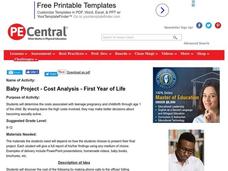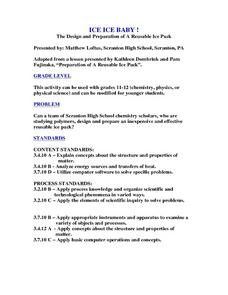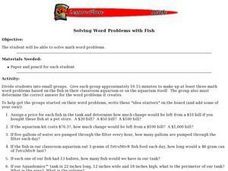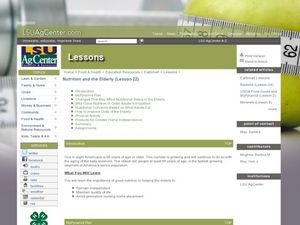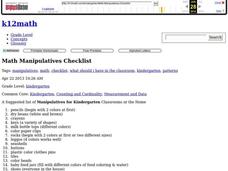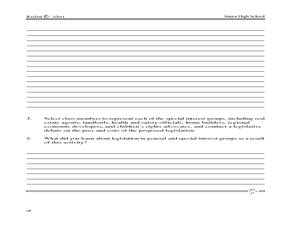Curated OER
Babies: What Do They Cost?
This is a great exercise to give your class a bit of a reality check about having a baby. Few of them realize what a tremendous expense it is for the first year alone. Have them estimate what they think it will cost before giving them...
Curated OER
Beanie Baby Bonanza
Third graders add and subtract decimals. In this third grade mathematics lesson, 3rd graders are given an imaginary $100 to purchase five Beanie Babies. Students determine which five they would like to purchase and estimate...
Yummy Math
Diapers
Most of your students probably think a car or college is the first big expense their parents could help them with, but as it turns out these kids have been costing their parents for their whole lives. Have they ever considered how much...
Curated OER
Juno - Movie Questions
This set of questions follows along with the movie Juno, which is about a 16-year-old getting pregnant and the resulting decisions she makes about the welfare of her baby. Give the class these questions to answer while they...
Achieve
Ivy Smith Grows Up
Babies grow at an incredible rate! Demonstrate how to model growth using a linear function. Learners build the function from two data points, and then use the function to make predictions.
Curated OER
What A Beautiful Baby!
In this career worksheet, students imagine that they are adopting a baby. They create a budget chart for all of the expenses needed to properly care for a baby. Students calculate the costs for a month, including babysitting.
Curated OER
Baby Project - Cost Analysis - First Year of Life
Students determine the costs associated with teenage pregnancy and childbirth through the child's first year. They consider prenatal and postnatal care for mother and child, clothing, food, equipment, childcare, etc. They present their...
Curated OER
Reproduction, Day 3: Parenthood
Teenagers explain the process from making the decision to have a baby to parenthood. They identify the positive and negative aspects of parenting. In small groups, they browse catalogs of baby equipment and evaluate the cost of...
Curated OER
Ice Ice Baby! The Design and Preparation of A Reusable Ice Pack
Students explore polymers by designing and preparing an inexpensive and effective reusable ice pack. They develop and test a design for a reusable ice pack in the science lab. Students apply chemical and physical properties of polymers...
Curated OER
The Berenstain Bears' Mad, Mad, Mad Toy Craze
Students explore personal finances. In this money management lesson plan, students read The Berenstain Bears' Mad, Mad, Mad Toy Craze. Students examine the spending habits of Brother Bear and Sister Bear. Students analyze opportunity...
Curated OER
Zoo Welcomes Baby Animals
Learners engage in activities to gain a better understanding of endangered animals. In these animal lessons, students use vocabulary and comprehension skills to gain a better understanding of endangered animals. They also watch video...
Curated OER
Solving Word Problems with Fish
Send your class fishing...for the right answers! Small groups collaborate to create math word problems based on the fish in their classroom aquarium or on the aquarium itself. After all groups determine the answer for their ownproblem,...
Student Handouts
A Society in Transition
Cover the 1980s in your class with a brief informational text and seven related questions. The one-page reading passage includes general information about jobs and skills, population patterns, and the AIDS epidemic.
Curated OER
Nutrition and the Elderly
Study the nutrition of elderly people and how it helps them to remain independent and healthy. Learners investigative the nutrition concerns of the elderly. MyPlate, vitamine requirements and sensory changes in the elderly are...
Curated OER
Agriculture, Weather, Economy and Indiana
Fourth graders, in groups, investigate the role of weather in Indiana's farming economy. They make a prediction as to weather and its effect on the economy of Indiana. They present their data using a media presentation of data...
Primary Resources
LO: To Solve Fraction Word Problems
What a terrific way to review fractions! Learners answer 20 word problems involving fractional amounts. This is a great way to connect classroom knowledge to real life. Be aware that this was written in the UK, and so there are no dollar...
Curated OER
Patterns
Explore early algebra by participating in a pattern identification activity using a random assortment of different household materials. The class creates, completes, and analyzes different patterns with the help of leggos, buttons,...
Curated OER
Adding Greater Numbers
In this addition worksheet, 3rd graders solve 12 addition math problems dealing with 4-digit numbers and money. Students answer 3 addition word problems and 2 addition problems with multiple choice answers.
Curated OER
R Blends
In this blends worksheet, students complete 7 sentences by choosing from 12 words given. Students find the 7 words in a word search. Students also unscramble 3 words.
Curated OER
Taronga Zoo
In this online Taronga Zoo learning exercise, students click on the underlined blue word or words to find the answers to twelve questions associated with the Taronga Zoo in Asia.
Curated OER
What are the Ethical Considerations of Radon?
In this radon contamination worksheet, students explore the legal and ethical issues associated with radon found in indoor air of homes. Students construct a set of laws that promote fairness to all sellers, buyers and real estate agents...
Curated OER
Immigration History Firsthand
Students interpret historical evidence presented in primary and secondary resources. In this immigration lesson, students conduct research regarding Ellis Island and the American immigrant experience. Students use...
Curated OER
Integrating Science and Literacy Through Novel Studies
You can use "The Toothpaste Millionaire" and other outstanding fiction to integrate science and literacy.
Curated OER
Problem Solving: Estimate or Exact?
In this number sense worksheet, 5th graders solve 6 word problems and explain why the answer makes sense. They use either estimated numbers or exact numbers as they solve the problems.






